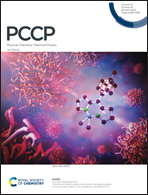Importance of intersystem crossing in the C(3P) + SiH4 reaction†
Abstract
The contribution of intersystem crossing (ISC) in the C(3P) + SiH4 reaction that leads to products formation in the singlet electronic state is investigated using a direct dynamics trajectory surface hopping (TSH) method with Tully's fewest switches algorithm. Interestingly, in contrast to the O(3P) + SiH4 reaction with no ISC effect, for the title reaction we observed ∼7% product formation through ISC despite weak spin–orbit coupling interactions (less than 25 cm−1) between the ground singlet and triplet states. This is presumably because of the topological differences in the potential energy surfaces of the two reactions at the entrance channel. The O(3P) + SiH4 reaction follows either an addition reaction (with shallow attractive potential and a late singlet–triplet crossing) or a direct abstraction pathway with singlet–triplet crossing at near or after the top of the barrier making ISC ineffective. On the other hand, an insertion mechanism is exclusively followed by the C(3P) + SiH4 reaction with no entrance barrier to the reaction in the triplet state. The triplet insertion complex initially formed (3H3SiCH) can go to the singlet state through ISC due to the fact that the triplet–singlet crossing is accessed several times during the course of the reaction. Our computed overall product angular distributions for H and H2 elimination channels are found to be broad and flat or nearly isotropic in nature indicating the formation of stable intermediate complexes, which corroborates the most recent crossed molecular-beam study.

- This article is part of the themed collection: 2020 PCCP HOT Articles


 Please wait while we load your content...
Please wait while we load your content...